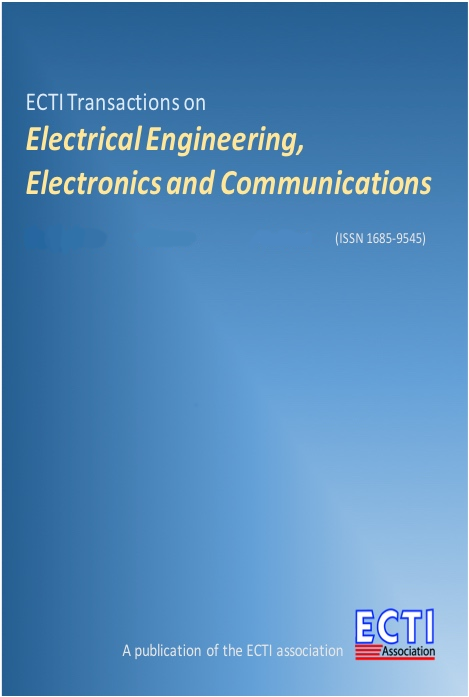Application of Frequency Control Techniques for Hot Tensile Testing in Induction Heating
Main Article Content
Abstract
This paper proposes the frequency control technique using a half-bridge resonance inverter for hot tensile testing in induction heating. The technique involves power regulation, high frequency pulse, frequency adjustment, and pulse generator controller based on the dsPIC33FJ16GS404 chip IC. Significantly, the inverter is controlled by two sections. Throughout the heating cycle, the first controller retains the inverter's operating frequency slightly above the resonant frequency, while the second keeps the phase angle of the current and voltage output in check to control the output power at a level suitable for changes in the tensile parameter workpieces. As a result, the inverter improves the efficiency of the prototype, which has 1.5 kW input power. Furthermore, it can heat three different sizes of steel workpieces for hot tensile testing, with diameters of approximately 3, 5, and 10 mm and lengths of approximately 50 and 70 mm, respectively.
Article Details

This work is licensed under a Creative Commons Attribution-NonCommercial-NoDerivatives 4.0 International License.
This journal provides immediate open access to its content on the principle that making research freely available to the public supports a greater global exchange of knowledge.
- Creative Commons Copyright License
The journal allows readers to download and share all published articles as long as they properly cite such articles; however, they cannot change them or use them commercially. This is classified as CC BY-NC-ND for the creative commons license.
- Retention of Copyright and Publishing Rights
The journal allows the authors of the published articles to hold copyrights and publishing rights without restrictions.
References
J. Davies and P. Simpson, Induction Heating Handbook. New York, NY, USA: McGraw-Hill, 1979.
S. Chudjuarjeen and C. Koompai, “A high-frequency induction cooker using qusai-resonant converter,” in 2007 4th International Conference on Electrical Engineering/Electronics, Computer, Telecommunications and Information Technology (ECTI-CON 2007), 2007, pp. 378–381.
S. Chudjuarjeen and C. Koompai, “Asymmetrical control with phase lock loop for induction cooking appliances,” in 2008 5th International Conference on Electrical Engineering/Electronics, Computer, Telecommunications and Information Technology (ECTI-CON 2008), 2008, pp. 1013–1016.
S. Chudjuarjeen, A. Sangswang, and C. Koompai, “LLC resonant inverter for induction heating with asymmetrical voltage-cancellation control,” in 2009 IEEE International Symposium on Circuits and Systems, 2009, pp. 2874–2877.
A. Polsripim, S. Chudjuarjeen, A. Sangswang, P. N. N. Ayudhya, and C. Koompai, “A soft switching class d current source inverter for induction heating with ferromagnetic load,” in 2009 International Conference on Power Electronics and Drive Systems (PEDS), 2009, pp. 877–881.
Y. Samart, C. Panithan, S. Chudjuarjeen, A. Sangswang, and C. koompai, “An automatic half-bridge resonant inverter with three-phase three-switch buck-type rectifier,” in 2010 IEEE Energy Conversion Congress and Exposition, 2010, pp. 2172–2176.
S. Chudjuarjeen, A. Sangswang, and C. Koompai, “An improved LLC resonant inverter for inductionheating applications with asymmetrical control,” IEEE Transactions on Industrial Electronics, vol. 58, no. 7, pp. 2915–2925, Jul. 2011.
J. Jittakort, S. Yachiangkam, A. Sangswang, S. Naetiladdanon, C. Koompai, and S. Chudjuarjeen, “A variable-frequency asymmetrical voltage-cancellation control of series resonant inverters in domestic induction cooking,” in 8th International Conference on Power Electronics - ECCE Asia, 2011, pp. 2320–2327.
J. Jittakort, A. Sangswang, S. Naetiladdanon, S. Chudjuarjeen, and C. Koompai, “LCCL series resonant inverter for ultrasonic dispersion system with resonant frequency tracking and asymmetrical voltage cancellation control,” in 41st Annual Conference of the IEEE Industrial Electronics Society (IECON 2015), 2015, pp. 2491–2496.
S. Yachiangkam, A. Sangswang, S. Naetiladdanon, C. Koompai, and S. Chudjuarjeen, “Steady-state analysis of ZVS and NON-ZVS full-bridge inverters with asymmetrical control for induction heating applications,” Journal of Power Electronics, vol. 15, no. 2, pp. 544–554, Mar. 2015.
J. Jittakort, A. Sangswang, S. Naetiladdanon, C. Koompai, and S. Chudjuarjeen, “Full bridge resonant inverter using asymmetrical control with resonant-frequency tracking for ultrasonic cleaning applications,” Journal of Power Electronics, vol. 17, no. 5, pp. 1150–1159, Sep. 2017.
S. Nilboworn, K. Mahamad, W. Sangchay, and P. Kongrueang, “Edge effect and its influence on the adjacent cavities in a composite insulator,” UTK Research Journal, vol. 14, no. 1, pp. 23–29, 2020.
C. Wisassakwichai, P. Phaochoo, E. Anusurain, C. Kamonkhantithorn, W. Methavithit, and W. Sirichanon, “Database building with Microsoft excel for voltage drop calculation according to thai electrical code 2013 with c++ builder,” (in Thai), UTK Research Journal, vol. 12, no. 2, pp. 119–135, 2018.
B. Sriboonreung, “Two output power control of induction cooker with full bridge inverter controlled by asymmetrical voltage control,” (in Thai), UTK Research Journal, vol. 13, no. 2, pp. 1–12, 2019.
J. Ekburanawat, “Full bridge switching power supply for a thermoelectric dehumidifier,” (in Thai), UTK Research Journal, vol. 13, no. 2, pp. 54–64, 2019.
A. Dominguez, L. A. Barragan, J. I. Artigas, A. Otin, I. Urriza, and D. Navarro, “Reduced-order models of series resonant inverters in induction heating applications,” IEEE Transactions on Power Electronics, vol. 32, no. 3, pp. 2300–2311, Mar. 2017.
J. Villa, J. I. Artigas, J. R. Beltran, A. D. Vicente, and L. A. Barragan, “Analysis of the acoustic noise spectrum of domestic induction heating systems controlled by phase-accumulator modulators,” IEEE Transactions on Industrial Electronics, vol. 66, no. 8, pp. 5929–5938, Aug. 2019.
A. G. Kothalkar and M. A. Ahire, “Hot tensile test- a literature review,” International Journal of Modern Trends in Engineering and Research, vol. 2, no. 7, pp. 1772–1776, Jul. 2015.
M. Ganapathy, N. Li, J. Lin, M. Abspoel, and D. Bhattacharjee, “A novel grip design for high-accuracy thermo-mechanical tensile testing of boron steel under hot stamping conditions,” Experimental Mechanics, vol. 58, no. 2, pp. 243–258, Feb. 2018.


